Low-Noise, Narrow-Linewidth Laser Systems, 1550 nm

- High-Power, Turnkey, Single-Frequency Laser Systems at 1550 nm
- Low-Noise Drive Electronics to Minimize RIN and Linewidth
- 20 MHz Current Modulation Bandwidth
- Linewidths as Low as 100 Hz Available
Narrow-Linewidth, Low-Noise Laser Systems, 1550 nm
The frequency noise spectral density gives a Lorentzian linewidth of 70 Hz for the ULN15TK and 43 kHz for the DFB15TK.
US Patents: 10193306, 10483718,
10476233, and 10454248

Please Wait
| Key Specification Comparison | ||
|---|---|---|
| Item # | ULN15TK | DFB15TK |
| Typical Linewidth | 100 Hz | 50 kHz |
| Typical RIN | -160 dBc/Hz | -150 dBc/Hz |
| Mode-Hop-Free Single-Frequency Operating Current Region |
Discontinuousa | Continuousb |
| Temperature Tuning Range | 0.32 nmc | 2 nmd |
| AC Current Modulation Depth | ±10 mA | ±100 mA |
| DC Current Modulation Depth | ±10 mA | ±10 mA |
Applications
- Optical Reference Laser
- LIDAR/LADAR
- Fiber Optic Sensing
- Quantum Optics
- Atomic Clocks
- Rubidium Cooling
- Coherent Communications
Features
- High-Power Turnkey Single-Frequency Laser Systems in the C-Band
- Ultra-Low-Noise (ULN), Narrow-Linewidth Laser System (US patents: 10193306, 10483718, 10476233, and 10454248):
- 100 Hz Typical Linewidth, 70 dB typical SMSR
- RIN of -160 dBc/Hz
- Discontinuous Mode-Hop-Free Regions 20 mA to 50 mA Wide
- Temperature Tuning Range of 0.32 nm with Simultaneous Current Tuning
- Distributed Feedback (DFB) Laser System:
- 50 kHz Typical Linewidth, 50 dB Typical Side-Mode Suppression Ratio (SMSR)
- Relative Intensity Noise (RIN) of -150 dBc/Hz
- Continuous Mode-Hop-Free Operating Current Region
- Temperature Tuning Range of 2 nm
- Low-Noise Drive Electronics to Minimize RIN and Linewidth
- Analog Modulation Inputs for DC Current, AC Current, and Laser Temperature
- Integrated Isolator to Minimize Effects of Back-Reflected Light
- Remote Operation and Set-Point Adjustment with Command-Line Interface via USB 2.0
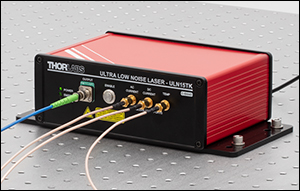
Click to Enlarge
Figure 1.1 The ULN15TK laser can be mounted to an optical table using four 1/4"-20 cap screws. The ULN15TK is pictured with a P3-1550PM-FC-5 PM fiber patch cable and three CA2912 SMA cables, which are connected to the optical output and analog modulation ports, respectively.
Thorlabs' single-frequency, turnkey, low-noise laser systems are ready-to-use laser systems that integrate our ULN15PC or DFB1550P diodes with a low-noise driver and temperature stabilization inside of a benchtop housing. To minimize the laser linewidth and relative intensity noise (RIN), these lasers include drive electronics that are designed to minimize the current noise. An isolator is integrated at the output of the lasers to minimize the impact of any back-reflected light on the lasers.
The ULN15TK is an ultra-low-noise (ULN) laser system based on a hybrid external-cavity semiconductor laser employing a fiber Bragg grating (FBG) for feedback to the laser cavity. This patented design enables exceptionally narrow Lorentzian linewidths of 100 Hz and the lowest available RIN of -160 dBc/Hz. When factory-set for optimized performance, this laser offers typical optical output powers of 120 mW with an SMSR of 70 dB. As a result of this unique design, the mode-hop-free single-frequency regions are not continuous as the laser current is adjusted, typically limited to 20 mA to 50 mA wide current regions. The temperature of the laser case is stabilized through a third temperature stabilization circuit to provide long-term power and wavelength stability when the system is used in standard laboratory environments.
The DFB15TK is based on a distributed feedback (DFB) cavity on the laser chip, providing single-frequency emission with typical relative intensity noise (RIN) of -150 dBc/Hz and typical linewidths of 50 kHz. Factory-set for optimized performance, this laser offers a minimum output power of 100 mW with a side-mode suppression ratio (SMSR) of 50 dB. This design allows for a broad, mode-hop-free, single-frequency operation range (350 mA to 1000 mA). The DFB15TK laser system can also be tuned by adjusting the current or the temperature of the laser chip, with a mode-hop-free temperature tuning range of up to 2 nm.
These lasers are designed with laser frequency locking applications in mind. The systems come equipped with two analog current modulation ports (DC and AC coupled) and an analog temperature modulation port. These modulation inputs can be used to lock the laser frequencies to optical cavities or referenced using servo electronics in order to build stable laser systems.
The optical outputs of these lasers are fiber-coupled via FC/APC bulkhead (2.0 mm narrow key) output connectors. For best performance, we recommend connecting our PM FC/APC fiber patch cables that contain PM1550-XP fiber, such as the P3-1550PM-FC-1 patch cable. Note that the polarization axis is aligned with the narrow key of the bulkhead connector.
The systems are powered by a 12 VDC, 4 A input. A DS12 power supply is provided with each laser; see the Shipping List tab for a complete list of items included with the device.
Thorlabs also offers the DFB13TK as a single-frequency, low-noise laser system at 1310 nm, similar to the DFB15TK laser system.
Single-Frequency Operation and Wavelength Tuning
Factory-set for single-frequency operation, these lasers have a preset drive current and temperature. When the laser is enabled using the push-button switch on the front panel (see Front & Back Panels tab), the laser operates at the preset current level. Each laser is shipped with a test data sheet taken at the preset operating conditions; click here for a sample data sheet. The user can adjust the operating current either by sending a command through USB communication (see Remote Operation below) or by applying small modulation to the current through one of the modulation ports on the front panel of the system (see Analog Modulation below). Adjusting the operating current results in both a change in the output power but also a change in the laser wavelength. In addition to the operating current, the laser chip or FBG temperature is also adjustable either through the command-line interface (USB) or the front-panel modulation port. The temperature changes are primarily useful for tuning the laser wavelength while maintaining a relatively constant output power. See the Graphs and Specs tabs for more information on current and temperature tuning of these lasers.
Analog Modulation
By controlling the laser's drive current or temperature, the laser's wavelength can be tuned free of mode-hopping within a small range around its set-point. Three analog modulation ports (SMA Female) are included on the front panel (see the Front & Back Panels tab). Two of the ports allow the laser current to be modulated by ±10 mA around the current set point: of these, the port labelled "AC Current" can support modulation frequencies up to 20 MHz, and the port labelled "DC Current" accepts frequencies from DC to 5 MHz. The third port, which is labelled "Temp", controls the FBG temperature (ULN15TK) or chip temperature (DFB15TK) and accepts modulation frequencies from DC to 1 Hz. To see how the laser wavelength can be tuned around its set-point, please see the wavelength tuning plots provided in the Graphs tab.
Each modulation port accepts a -5 V to 5 V input signal. To convert the modulation voltage into a current or temperature change, see the Specs tab.
Committed to Your Success
I am happy to assist with questions concerning our single-frequency, low-noise, turnkey laser systems. If our catalog offerings do not meet your needs, these products can be customized using some of our DBR and DFB single-frequency laser devices that require a drive current ≤1 A. The following (wavelengths / incorporated laser) combinations are available for our turnkey systems:If you are interested in these laser systems, I invite you to contact us with your questions, comments, or requests.
Remote Operation
Remote operation is also possible by connecting the laser to a PC (not included) via the USB port on the back of the unit and using a command line interface. In addition to basic functions such as turning the laser on and off or reading status indicators, the command line enables the user to modify the laser operating set-points. The full list of commands can be found in the laser manual. A USB-AB-72 USB 2.0 Type-A to Mini-B Cable is included with each device.
Adjusting the laser parameters (operating current and temperature) can be used for tuning the laser power or wavelength. Typical performance plots that demonstrate the laser's center wavelength tuning and the single-mode operating regions can be found on the Graphs tab. Please note that specific performance data is provided on the datasheet shipped with each device.
A 9-Pin male D-Sub connector is also included on the back panel of the system for RS-485 communication protocol. Please refer to the Pin Diagrams tab for the pin assignment of the connector.
Mounting
For mounting to an optical table, the compact housing of these benchtop lasers features four clearance holes each for M6 or 1/4" cap screws.
| Item # | ULN15TK | DFB15TK |
|---|---|---|
| Laser Specificationsa | ||
| Center Wavelengthb | 1550 nm ± 15 nm | 1555 nm ± 10 nm |
| Output Powerc | >90 mW (Typ. 120 mW) | ≥100 mW |
| Linewidthd | <250 Hz (Typ. 100 Hz) | <100 kHz (Typ. 50 kHz) |
| Relative Intensity Noise (RIN)e | -160 dBc/Hz | -150 dBc/Hz |
| Side-Mode Suppression Ratio (SMSR) | >60 dB (Typ. 70 dB) | >30 dB (Typ. 50 dB) |
| Polarization Extinction Ratio (PER) | >18 dB | 23 dB |
| Output Isolation | >25 dB | 50 dB |
| Mode-Hop-Free Operating Current | N/A | 350 mA - 1000 mA |
| Mode-Hop-Free Power Range | N/A | 40 mW - 100 mW |
| Slope Efficiency | - | 0.15 W/A |
| Threshold Current | 50 mA | 50 mA |
| Current Tuning Coefficient | 0.25 pm/mA | 0.006 nm/mA |
| FBG Temperature Tuning Coefficient | 8 pm/°C | N/A |
| FBG Temperature Tuning Range | 10 °C - 60 °C | N/A |
| Laser Chip Tuning Coefficient | - | 0.10 nm/°C |
| Laser Chip Temperature Tuning Range | - | 15 °C - 35 °C |
| Fiber Specifications | ||
| Output Fiber Typef | Corning® PM15-U25D | PM1550 |
| Output Fiber Connectors | FC/APC Compatible, 2.0 mm Narrow Key | |
| External Modulation Specifications | ||
| AC Voltage to Current Conversion Rate | 2 mA/V | 20 mA/V |
| DC Voltage to Current Conversion Rate | 2 mA/V | |
| Voltage to Temperature Conversion Rate | Firmware Adjustable (Default = 0.2 °C/V) | |
| Input Voltage Range (All Ports) | -5 V to 5 V | |
| Input Impedance (All Ports) | 1 kΩ | |
| AC Current Modulation Frequency Rangeg | 2 kHz to 20 MHz | |
| DC Current Modulation Frequency Rangeg | DC to 5 MHz | |
| Temperature Modulation Frequency Range | DC to 1 Hz | |
| Absolute Maximum Ratings | |
|---|---|
| Absolute Maximum Output Power | 145 mW |
| Operating Temperature | 15 °C to 30 °C |
| Storage Temperature | -10 °C to 40 °C |
| General Specifications | |
|---|---|
| Input Voltage | 12 V (from DS12 Power Supply) |
| Input Power | 20 W (Max) |
| Dimensions (W x D x H) | 10.00" x 5.31" x 2.93" (254.0 mm x 135.0 mm x 74.4 mm) |
| Weight | 4.7 lbs (2.1 kg) |
| Laser Class | 1M |
The plots below represent the relative intensity noise (RIN) and frequency noise for the low-noise, single-frequency laser systems.
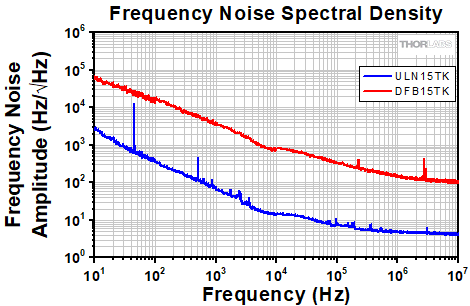
Click to Enlarge
Example frequency noise data for the ULN15TK and DFB15TK laser systems operated at the factory-set conditions.
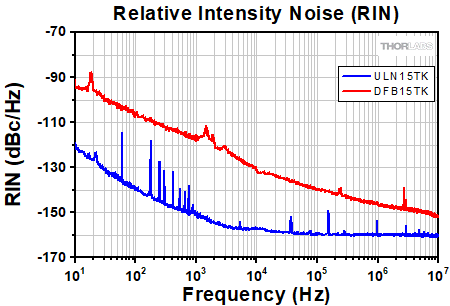
Click to Enlarge
The typical low-frequency relative intensity noise (RIN) for a ULN15TK and DFB15TK laser system operated at the factory-set conditions.
The plots below represent the typical performance of the ULN15TK ultra-low-noise laser system. Specific performance data is provided on the datasheet shipped with each device; click here for a sample data sheet.
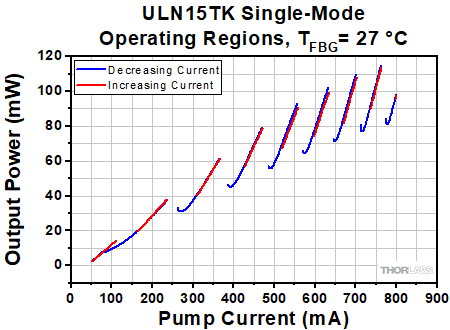
Click to Enlarge
Click Here for Data
The typical single mode operating regions for a ULN15TK laser system operated at a Fiber Bragg Grating temperature (TFBG) of 27 °C. Multimode regions have been removed.
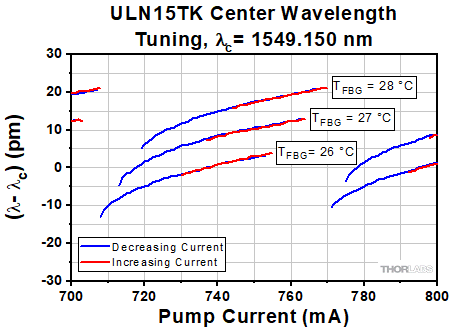
Click to Enlarge
Click Here for Data
The center wavelength (λc) tuning with changes in the pump current and Fiber Bragg Grating temperature (TFBG). Multimode regions have been removed.
The plots below represent the typical performance of the DFB15TK low-noise laser system. Specific performance data is provided on the datasheet shipped with each device; click here for a sample data sheet.
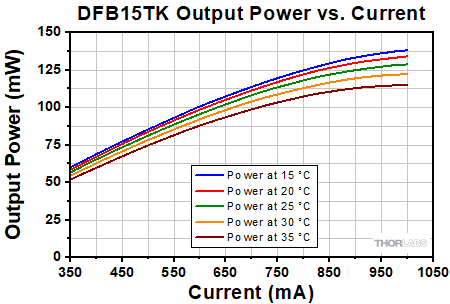
Click to Enlarge
Click Here for Data
Example output power vs. current data for a DFB15TK laser system operated at factory-set conditions.
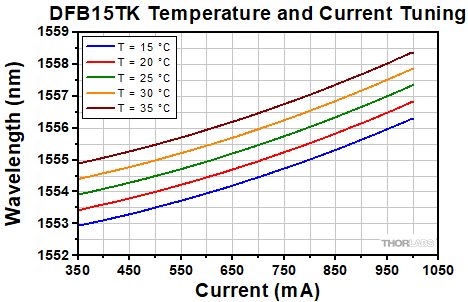
Click to Enlarge
Click Here for Data
Example temperature and current tuning for a DFB15TK laser system operated at the factory-set conditions.
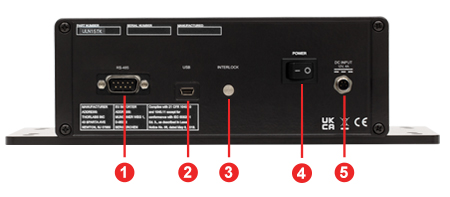
Click to Enlarge
Figure 4.2 ULN15TK Turnkey ULN Laser Back Panel
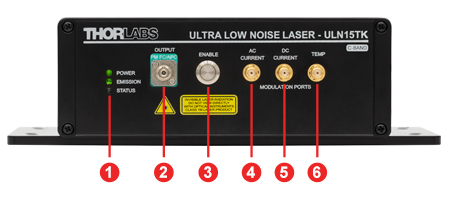
Click to Enlarge
Figure 4.1 ULN15TK Turnkey ULN Laser Front Panel
| Front Panel | |
|---|---|
| Call Out | Description |
| 1 | Status Indicator LEDs |
| 2 | Laser Output Port (FC/APC, 2.0 mm Narrow Key, PM Fiber Output) |
| 3 | Laser Enable Push-Button Switch |
| 4 | AC Current Modulation Input (SMA Female) |
| 5 | DC Current Modulation Input (SMA Female) |
| 6 | Temperature Control Modulation Input (SMA Female) |
| Back Panel | |
|---|---|
| Call Out | Description |
| 1 | RS-485 Communication (DB-9 Male) |
| 2 | USB Communication (USB Mini-B) |
| 3 | Remote Interlock Pin (2.5 mm Mono Phono Female) |
| 4 | Power Switch |
| 5 | DC Input (M8 Connector for the DS12 Power Supply) |
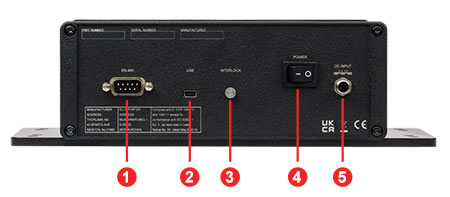
Click to Enlarge
Figure 4.4 DFB15TK Turnkey DFB Laser Back Panel
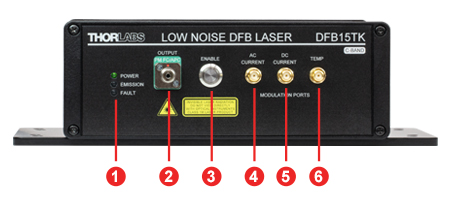
Click to Enlarge
Figure 4.3 DFB15TK Turnkey DFB Laser Front Panel
| Front Panel | |
|---|---|
| Call Out | Description |
| 1 | Status Indicator LEDs |
| 2 | Laser Output Port (FC/APC, 2.0 mm Narrow Key, PM Fiber Output) |
| 3 | Laser Enable Push-Button Switch |
| 4 | AC Current Modulation Input (SMA Female) |
| 5 | DC Current Modulation Input (SMA Female) |
| 6 | Temperature Control Modulation Input (SMA Female) |
| Back Panel | |
|---|---|
| Call Out | Description |
| 1 | RS-485 Communication (DB-9 Male) |
| 2 | USB Communication (USB Mini-B) |
| 3 | Remote Interlock Pin (2.5 mm Mono Phono Female) |
| 4 | Power Switch |
| 5 | DC Input (M8 Connector for the DS12 Power Supply) |
ULN15TK Pin Diagrams
USB 2.0 Communication
USB Mini-B
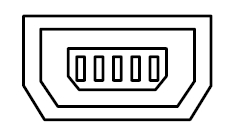
Input for Analog Modulation
SMA Female

Input Voltage: -5 V to 5 V
Input Impedance: 1 kΩ
AC Current Modulation Frequency Range: 2 kHz to 20 MHz*
DC Current Modulation Frequency Range: DC to 5 MHz*
*The specified bandwidth refers to the 3 dB electrical bandwidth of the modulation circuits. The laser response has a slow roll-off for frequencies above 1 MHz.
RS-485 Communication
9-Pin Male D-Sub Connector 
| Pin Assignment | |
|---|---|
| Pin | Output Signal |
| 1 | RS-485 Half-Duplex T/R+ |
| 2 | RS-485 Half-Duplex T/R- |
| 3 | Not Connected |
| 4 | Not Connected |
| 5 | Ground |
| 6 | Not Connected |
| 7 | Ground |
| 8a | Do Not Connect |
| 9a | Do Not Connect |
DFB15TK Pin Diagrams
USB 2.0 Communication
USB Mini-B

Input for Analog Modulation
SMA Female

Input Voltage: -5 V to 5 V
Input Impedance: 1 kΩ
AC Current Modulation Frequency Range: 2 kHz to 20 MHz*
DC Current Modulation Frequency Range: DC to 5 MHz*
*The specified bandwidth refers to the 3 dB electrical bandwidth of the modulation circuits. The laser response has a slow roll-off for frequencies above 1 MHz.
RS-485 Communication
9-Pin Male D-Sub Connector 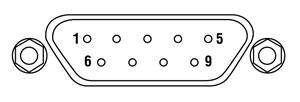
| Pin Assignment | |
|---|---|
| Pin | Output Signal |
| 1 | RS-485 Half-Duplex T/R+ |
| 2 | RS-485 Half-Duplex T/R- |
| 3 | Not Connected |
| 4 | Not Connected |
| 5 | Ground |
| 6 | Not Connected |
| 7 | Ground |
| 8a | Do Not Connect |
| 9a | Do Not Connect |
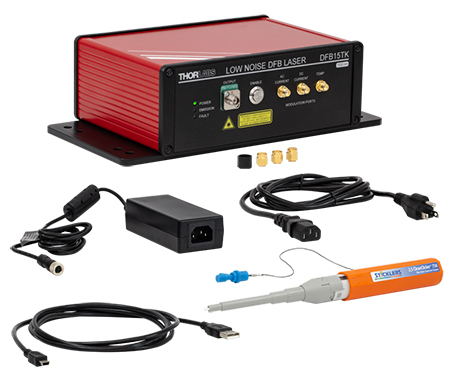
Click to Enlarge
Figure 6.1 DFB15TK Laser System and Accessories
The ULN15TK Turnkey Ultra-Low-Noise (ULN) Laser System ships with the following components:
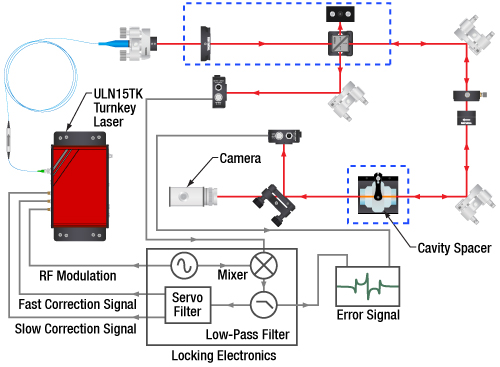
Click for Details
Figure 7.1 Experimental Setup for Laser Stabilization
Laser Stabilization
The ULN15TK turnkey ultra-low noise laser offers exceptional optical spectral purity and is configured for out-of-the-box use with little setup effort. However, for the most demanding applications, such as optical clocks and high-resolution spectroscopy, active electronic feedback may be required to further suppress technical noise and drifts. This turnkey laser conveniently provides multiple high-bandwidth analog modulation ports for locking to external optical references such as an optical cavity or an atomic/molecular transition.
Thorlabs offers low loss supermirrors on their own or integrated into custom reference cavities. In Figure 7.1, we show an example of how the Pound-Drever-Hall (PDH) locking scheme is used to lock the ULN15TK laser to a reference cavity comprised of XM12R8 and XM12P8 crystalline supermirrors attached to an ultra-low expansion glass spacer. The RF modulation input conveniently permits the PDH sidebands to be generated without an external optical modulator. Demodulation of the reflected signal from the cavity yields an error signal which can be processed with a servo filter to maintain resonance with the optical cavity. This turnkey laser provides a high-bandwidth DC-coupled current modulation port to correct for fast fluctuations, and a slower temperature modulation port with larger range to correct for slower drifts.
| Key Specification Comparison | ||
|---|---|---|
| Item # | ULN15TK | DFB15TK |
| Typical Linewidth | 100 Hz | 50 kHz |
| Typical RIN | -160 dBc/Hz | -150 dBc/Hz |
| Mode-Hop-Free Single-Frequency Operating Current Region |
Discontinuousa | Continuousb |
| Temperature Tuning Range | 0.32 nmc | 2 nmd |
| AC Current Modulation Depth | ±10 mA | ±100 mA |
| DC Current Modulation Depth | ±10 mA | ±10 mA |
The ULN15TK and DFB15TK are both single-frequency turnkey laser systems that are equipped with low-noise drive electronics. Both systems enable laser frequency modulation, which can be utilized along with locking electronics to lock the laser frequency to optical references or cavities.
The ultra-low-noise (ULN) system provides exceptionally narrow Lorentzian linewidth (typ. 100 Hz) and record low RIN (typ. -160 dBc/Hz) for applications that require such demanding noise performance. The ULN design is based on a hybrid external-cavity semiconductor laser employing a fiber Bragg grating (FBG) for feedback to the laser cavity. As a result, the mode-hop-free single-frequency regions of the ULN are not continuous as the laser current is adjusted. Each mode-hop-free single-frequency region is typically limited to 20 mA to 50 mA of drive current (see Graphs tab for performance plots of the ULN15TK). The ULN wavelength can be adjusted via both current adjustment of the chip and temperature adjustment of the FBG. The broadest tuning range for a ULN is achieved via FBG temperature adjustment and is typically limited to <0.4 nm (with FBG temperature adjusted by approximately 40 °C). In order to maintain single-frequency operation as the temperature is tuned over a broad range, the laser current needs to be adjusted simultaneously.
The DFB15TK design is based on a distributed feedback (DFB) cavity on the laser chip. This design allows a much broader mode-hop-free single-frequency operation range (350 mA to 1000 mA). The Lorentzian linewidth of the laser is broader than the ULN with a typical value of 50 kHz, and the RIN is also higher with a typical value of -150 dBc/Hz. The linewidth and RIN of the DFB15TK are still exceptionally low for this laser type thanks to the low-noise electronics and turnkey system. The DFB can also be tuned in both ways by adjusting the current or the temperature of the laser chip. The broadest tuning can be achieved by adjusting the chip temperature and a typical tuning up to 2 nm (with chip temperature adjusted by 20 °C) can be achieved. Unlike the ULN, the DFB stays in single-frequency mode as the temperature is tuned without the need to simultaneously adjust the current.
In summary, the ULN offers superior phase noise (linewidth) and intensity noise (RIN) performance, while the DFB offers broader tuning and a broader mode-hop-free single-frequency operating region. The DFB is also a lower cost alternative to the ULN for applications that are less demanding on noise or linewidth.
| Posted Comments: | |
Wei She
(posted 2025-03-21 15:58:23.207) Hi Thorlabs Tech support,
As mentioned in the user manual of DFB15TK, it is labeled as Class1M laser. Since its typical output power is 100mW, I wonder how the power can be eye-safe?
(For class 1M lasers, as long as the cross section of the beam is not reduced by additional, optical instruments - such as lenses or telescopes - there is no danger to the human eye.)
Best regards,
Wei cdolbashian
(posted 2025-04-09 11:47:19.0) Thank you for reaching out to us with this inquiry. The specification of 1M was determined based on the IEC standards which classify laser power passing through various "apertures" at varying distances. In this case, although the power is 100mW, the beam is coming from a fiber bulkhead, from a fiber with a 0.13 NA. Due to this, combined with the center wavelength of 1550nm, and the expected CW exposure of the device, the classification results in a class 1M laser. jensen ackles
(posted 2025-02-18 03:17:03.6) St.jensen ackles
The Structural Quantum Optics (SQO)group
Dr.Ebrahim Karimi
Associate Professor
Physics department,University of Ottawa
Hello
I am writing to you from the Department of Physics, University of Ottawa, Canada.
Thank you for your site and good sales management
We intend to buy a ULN15TK model laser from you.
We know that this laser has 3 inputs to adjust the temperature
Please explain how accurately we can adjust the temperature of the FPG or the device itself. Please specify the limits and also tell the limit of accuracy of adjustment in terms of current.
We need the laser to be able to adjust the wavelength with high precision.
also for DFB15TK model. tdevkota
(posted 2025-02-24 01:12:56.0) Thank you for contacting Thorlabs. The three inputs on the front panel are not all for temperature tuning, but current modulation on two ports and the third is for temperature. In practice, current modulation is used to tune and stabilize the laser, whereas temperature tuning allows access to different tuning ranges. The tuning coefficient and tuning range specifications for the lasers can be found under the Specs tab. Also, each laser is shipped with a test data sheet recorded at the preset operating conditions, which includes the tuning coefficients specific to the unit. Here is a sample data sheet: https://www.thorlabs.com/images/tabimages/DFB15TK_Sample_Datasheet.pdf. I have reached out to you directly to further discuss your application. Oliver Dölle
(posted 2023-04-03 14:53:43.483) Hi,
we will integrate the ULN15TK in our Laser stabilization system. Therefore I need the dimensions of the ULN15TK. Can you send me any technical drawings? Perhaps you have even a CAD model (step or iges)?
That would help me a lot!
Thank you,
Oliver Dölle, zeptocision GmbH cdolbashian
(posted 2023-04-03 02:47:49.0) Thank you for reaching out to us Oliver! These types of information can be found by clicking the red-colored "Docs" icon to the left of each product part number within the overview tab above. |

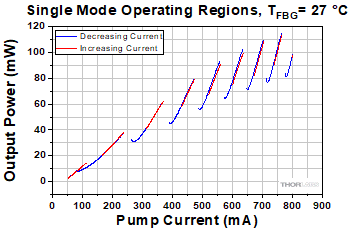 Click to Enlarge
Click to EnlargeClick for Data
Figure G1.1 This graph shows the typical single mode operating regions for a ULN15TK laser system operated at a fiber Bragg grating temperature (TFBG) of 27 °C. Multimode regions have been removed.
- 100 Hz Typical Lorentzian Linewidth
- -160 dBc/Hz Typical Relative Intensity Noise (RIN)
- 70 dB Typical Side-Mode Suppression Ratio (SMSR)
- 120 mW Typical Output Power
Thorlabs' ULN15TK Turnkey, Ultra-Low-Noise (ULN) Laser System is a ready-to-use laser system that integrates our ULN15PC laser, which has a patented fiber Bragg grating (FBG) based design, with a low-noise driver and temperature stabilization inside of a benchtop housing. The temperature of the laser case is stabilized through a third temperature stabilization circuit to provide long-term power and wavelength stability when the system is used in standard laboratory environments. See the blue info icon (![]() ) in Table G1.2 for typical performance specifications. Specific wavelengths within the center wavelength range, including 1560 nm for frequency doubling to access rubidium transitions, are available upon request.
) in Table G1.2 for typical performance specifications. Specific wavelengths within the center wavelength range, including 1560 nm for frequency doubling to access rubidium transitions, are available upon request.
The ULN15TK laser system provides exceptionally narrow Lorentzian linewidth (typ. 100 Hz) and the lowest available RIN (typ. -160 dBc/Hz) for applications that require demanding noise performance. The ULN design is based on a hybrid external-cavity semiconductor laser employing a fiber Bragg grating (FBG) for feedback to the laser cavity. As a result, the mode-hop-free single-frequency regions of the ULN are not continuous as the laser current is adjusted. Each mode-hop-free single-frequency region is typically limited to 20 mA to 50 mA of drive current (see Graphs tab). The ULN wavelength can be adjusted via both current adjustment of the chip and temperature adjustment of the FBG. In order to maintain single-frequency operation as the temperature is tuned over a broad range, the laser current needs to be adjusted simultaneously.
The system comes equipped with two analog current modulation ports (AC and DC coupled) and an analog temperature modulation port, which can be used to lock the laser frequency to optical cavities or a reference using servo electronics in order to build stable laser systems. Remote operation is possible by connecting the laser to a PC and using a command line interface.
The optical output of this laser is fiber-coupled via an FC/APC bulkhead (2.0 mm narrow key) output connector. For best performance, we recommend connecting our PM FC/APC fiber patch cables that contain PM1550-XP fiber. Each laser is shipped with a DS12 power supply; see the Shipping List tab for a complete list of items included with the device.
Specific wavelengths within the center wavelength range, including 1542 nm and 1560 nm, are available upon request. Please contact Tech Sales for more information.

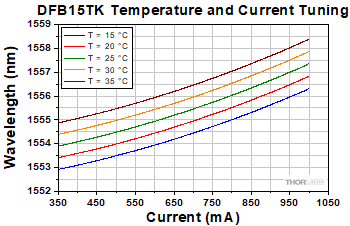
Click to Enlarge
Click Here for Data
Figure G2.1 Example temperature and current tuning for a DFB15TK laser system operated at the factory-set conditions.
- 50 kHz Typical Lorentzian Linewidth
- -150 dBc/Hz Typical Relative Intensity Noise (RIN)
- Continuous Mode-Hop-Free Single Frequency Operation
- 2 nm Temperature Tuning Range
Thorlabs' DFB15TK Turnkey, Low-Noise Distributed Feedback (DFB) Laser System is a ready-to-use laser system that integrates our DFB1550P with a low-noise driver and temperature stabilization inside of a benchtop housing. See the blue info icon (![]() ) in Table G2.2 for typical performance specifications. Each DFB laser system ships with individual test data; click here for a sample data sheet.
) in Table G2.2 for typical performance specifications. Each DFB laser system ships with individual test data; click here for a sample data sheet.
The DFB design allows a broad mode-hop-free single-frequency operation region (350 mA to 1000 mA), while maintaining a narrow 50 kHz Lorentzian linewidth and a typical relative intensity noise (RIN) of -150 dBc/Hz. Wavelength tuning can be accomplished by adjusting the current or the temperature of the laser chip, with typical temperature tuning of up to 2 nm (with the chip temperature adjusted by 20 °C). The DFB15TK will remain single-frequency as the temperature is tuned without the need to simultaneously adjust the current.
The system comes equipped with two analog current modulation ports (AC and DC coupled) and an analog temperature modulation port, which can be used to lock the laser frequency to optical cavities or a reference using servo electronics in order to build stable laser systems. Remote operation is possible by connecting the laser to a PC and using a command line interface.
The optical output of this laser is fiber-coupled via an FC/APC bulkhead (2.0 mm narrow key) output connector. For best performance, we recommend connecting our PM FC/APC fiber patch cables that contain PM1550-XP fiber. Each laser is shipped with a DS12 power supply; see the Shipping List tab for a complete list of items included with the device.
 Products Home
Products Home
















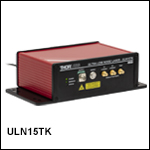
 Zoom
Zoom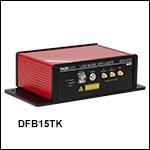
 Low-Noise, Narrow-Linewidth Lasers, 1550 nm
Low-Noise, Narrow-Linewidth Lasers, 1550 nm